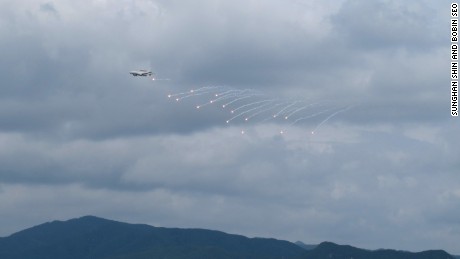between the two KoreasPyongyang views them as a provocation and prelude to warBut for South Korean residents near the border, they're intended to reassure
Pocheon, South Korea (CNN)On the side of a hill in Pocheon, about 18 miles (30 kilometers) from the Demilitarized Zone that separates North and South Korea, targets are laid out.
They're huge painted numbers and drawings of tanks bearing the North Korean star emblem.
Through a megaphone, a soldier announces what target to watch. A South Korean F-16 fighter jet screams over shortly after, dropping a bomb right on the spot.
Next up we're treated to the impressive sight of an E-737 "Peace Eye," a state-of-the-art surveillance aircraft that can detect movement across most of North Korea's airspace from behind the South Korean border.
We'd been given rare access to a live-fire exercise involving armed forces from South Korea and the United States.
series of mainly computer-simulated drills involving an estimated 80,000 troops. Its aim is to simulate the defense of South Korea from an attack by the North.
From behind us, the roar of anti-aircraft canon shakes the ground beneath us and leaves us coughing through the thick, acrid smoke. It smells like the end of a major fireworks display on New Year's Eve.
A flight of Surion helicopters, commonly used to transport troops, launches flares designed to evade North Korean surface-to-air missiles.
Commandos then rappel down ropes to the ground -- simulating the infiltration of enemy lines.

E-737 "Peace Eyes": A surveillance aircraft that can detect movement.
"Our soldiers are ready and able," says Battalion Commander Heo Jing-Nyeong, of the South Korean army. "With the will and courage to fight against the enemy."
U.S. Private First Class Israel Corona, part of the American military contingent, tells us, "We're just ready to fight tonight."
North Korean ire
This drill happens every three to five years, with around 3,000 South Korean and American military personnel.
No comments:
Post a Comment